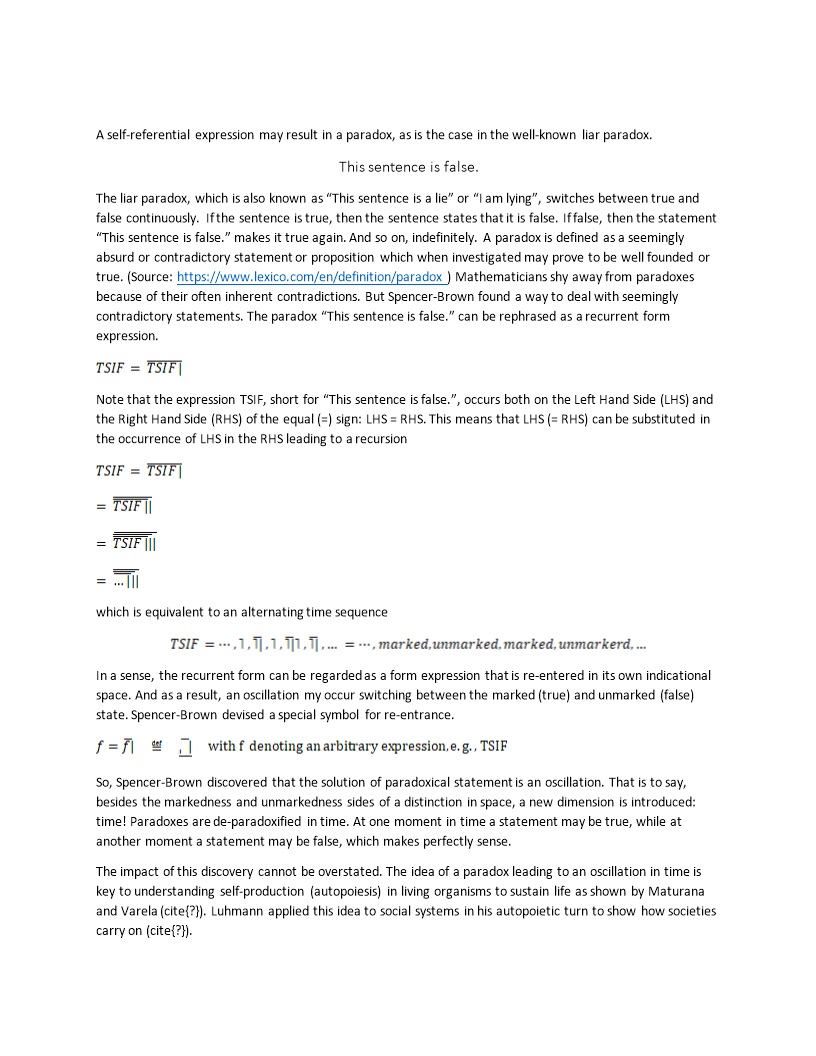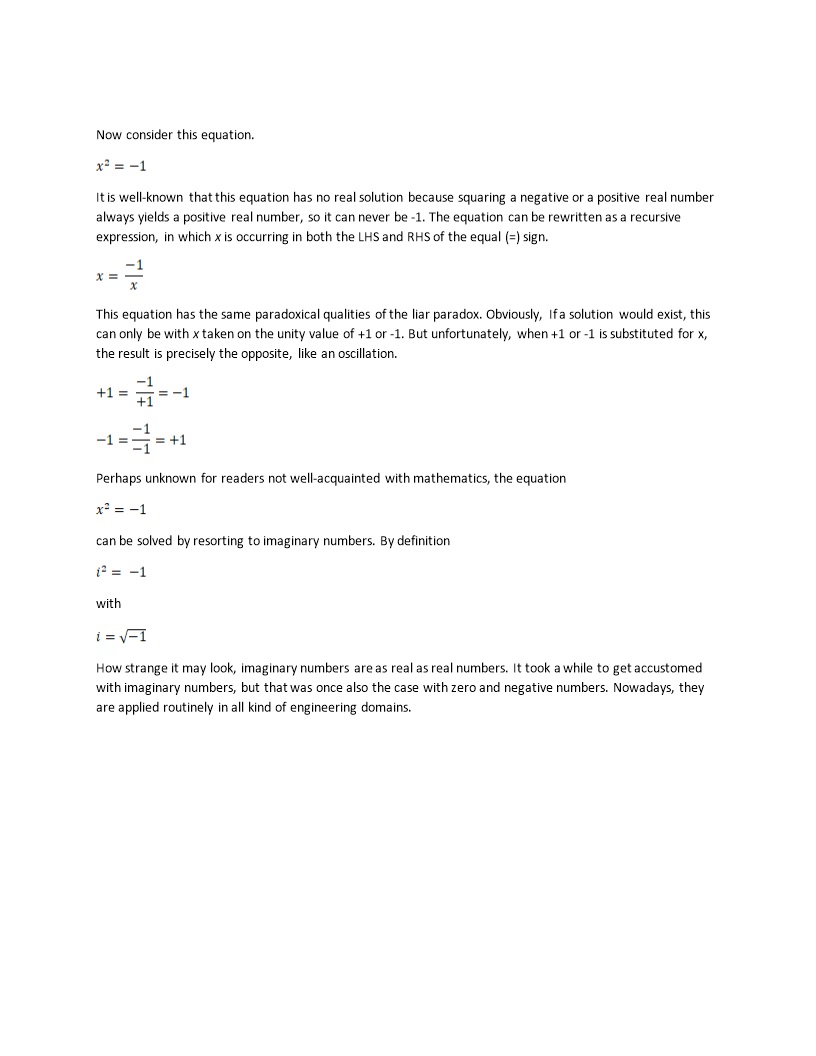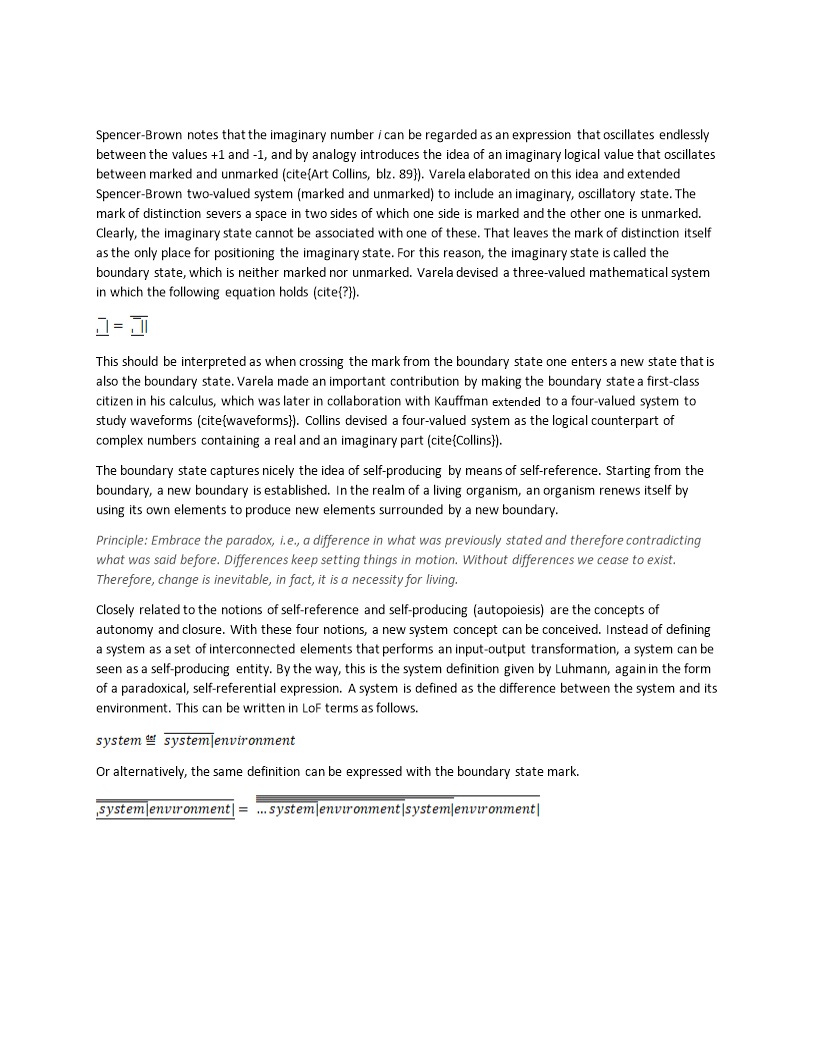Self-Reference in a Three-Valued System
References:
- Paradox
- Brown 4 (Arthur Collins, 1 januari 2017)
- Self-reference calculus (Varela, F.J., 1 januari 1975)
- Form dynamics (Kauffman, L.H. and Varela, F.J., 1 januari 1980)
Statement: Embrace the paradox, i.e., a difference in what was previously stated and therefore contradicting what was said before. Differences keep setting things in motion. Without differences we cease to exist. Therefore, change is inevitable, in fact, it is a necessity for living.
Aspect: Reflexive Domain, Principle: We got to move, Principle page: Principles and Ground Rules
| Statement page | Statement |
|---|---|
| Exploring Change | The constant factor in life is movement. |
| Self-Reference in a Three-Valued System | Embrace the paradox, i.e., a difference in what was previously stated and therefore contradicting what was said before. Differences keep setting things in motion. Without differences we cease to exist. Therefore, change is inevitable, in fact, it is a necessity for living. |
| The Autopoietic Turn | Humans and social systems operate autonomously and my react when irritated. |
Principles, aspects and statements overview
- Create room for change, defined in page: Principles and Ground Rules
- Systems Thinking, defined in page: Principles and Ground Rules
- Hard Systems Thinking – System Dynamics (A system comprised of a number of interacting feedback loops is a complex system whose behavior can surprise us.)
- Systems Thinking (A system as a whole is comprised of parts. Systems thinking is about understanding the interactions between the parts.)
- Critical Reflection, defined in page: Principles and Ground Rules
- Determining Boundary Judgements with CSH (A constructive dialog can take place on the basis of first and second order boundary judgments.)
- Self-observation (Concentrate on how to look, instead of what to see.)
- Self-observation (You need someone else to point out your blind spots to you.)
- Diversity in opinions, defined in page: Principles and Ground Rules
- Worldview, defined in page: Principles and Ground Rules
- Model Building - Human Activity Systems (A worldview (Weltanschauung) captures the beliefs, desires and intentions of a person.)
- Model Building - Human Activity Systems (The PQR formula (what, how, why) is pivotal for capturing worldviews.)
- Soft Systems Thinking – Soft Systems Methodology (People differ in worldviews, but nevertheless they typically adhere to aspects of multiple worldviews, which provides room for accommodation.)
- We got to move, defined in page: Principles and Ground Rules
- Reflexive Domain, defined in page: Principles and Ground Rules
- Exploring Change (The constant factor in life is movement.)
- Self-Reference in a Three-Valued System (Embrace the paradox, i.e., a difference in what was previously stated and therefore contradicting what was said before. Differences keep setting things in motion. Without differences we cease to exist. Therefore, change is inevitable, in fact, it is a necessity for living.)
- The Autopoietic Turn (Humans and social systems operate autonomously and my react when irritated.)
- Tradition, defined in page: Principles and Ground Rules
- Exploring Change (A system has to become what it is not, and yet remain the same.)
- Some-thing from No-thing (The relationship between things, including humans, is what matters. Something or someone cannot stand or be taken on its own.)
- Determine the right direction, defined in page: Principles and Ground Rules
- Cultural Identity, defined in page: Principles and Ground Rules
- Investigating Identity (Group identity refers to a person’s sense of belonging to a particular group.)
- Research Philosophy and Process (Research approach must be “for you, and with you”, instead of “for you, but not with you”.)
- Right Things, defined in page: Principles and Ground Rules
- Co-dependency, defined in page: Principles and Ground Rules
- Ethics of Care, defined in page: Principles and Ground Rules
- Investigating Identity (Ethics of Care is a retreat to first principles to be part of a group to protect and to provide meaning.)
- Responsible Setting for Social Innovation (Each stakeholder facilitates other stakeholders in addressing a societal challenge.)
- Some-thing from No-thing (We rely on each other and therefore we should care for each other.)
Perhaps the most important contribution of LoF is when Spencer-Brown discusses in chapter 11 and 12 self-referential form expressions. These are circular expressions that lead to recursion. A famous example for illustrating recursion is the “Droste effect”, named after a Dutch brand of cocoa. It is the effect of a picture recursively appearing within itself, in a place where a similar picture would realistically be expected to appear.
A self-referential expression may result in a paradox, as is the case in the well-known liar paradox. This sentence is false. The liar paradox, which is also known as “This sentence is a lie” or “I am lying”, switches between true and false continuously. If the sentence is true, then the sentence states that it is false. If false, then the statement “This sentence is false.” makes it true again. And so on, indefinitely. A paradox is defined as a seemingly absurd or contradictory statement or proposition which when investigated may prove to be well founded or true. (Source: https://www.lexico.com/en/definition/paradox) Mathematicians shy away from paradoxes because of their often inherent contradictions. But Spencer-Brown found a way to deal with seemingly contradictory statements. The paradox “This sentence is false.” can be rephrased as a recurrent form expression.
Formulas
- [math]\displaystyle{ \begin{array}{lcl}TSIF & = & \overline{TSIF|}\end{array} }[/math]
- [math]\displaystyle{ \begin{array}{lcl} TSIF & = & \overline{TSIF|} \\ & = & \overline{\overline{TSIF|}\Big|} \\ & = & \overline{\overline{\overline{TSIF|}\Big|}\bigg|} \\ & = & \overline{\overline{\overline{\cdots|}\Big|}\bigg|} \end{array} }[/math]
- [math]\displaystyle{ TSIF \;\; = \;\; \cdots , \overline{\;\;|} , \overline{\overline{\;\;|}\Big|} , \overline{\;\;|} , \overline{\overline{\;\;|}\Big|} , \overline{\;\;|} , \overline{\overline{\;\;|}\Big|} , \cdots \;\; = \;\; \cdots , \mbox{marked, unmarked, marked, unmarked, marked, unmarked}, \cdots }[/math]
- [math]\displaystyle{ f = \overline{f|} \;\;\; \stackrel{def}{=} \;\;\; \overline{\underline{_{\lfloor}\;\;}\bigg|} \;\;\; \mbox{with $f$ denoting an arbitrary expression, e.g., $TSIF$} }[/math]
- [math]\displaystyle{ x^2 = -1 }[/math]
- [math]\displaystyle{ x = \frac{-1}{x} }[/math]
- [math]\displaystyle{ \begin{array}{lclcl} +1 & = & \frac{-1}{+1} & = & -1 \\ -1 & = & \frac{-1}{-1} & = & +1 \end{array} }[/math]
- [math]\displaystyle{ +1 = \frac{-1}{+1} = -1 }[/math]
- [math]\displaystyle{ -1 = \frac{-1}{-1} = +1 }[/math]
- [math]\displaystyle{ x^2 = -1 }[/math]
- [math]\displaystyle{ i^2 = -1 }[/math]
- [math]\displaystyle{ i = \sqrt{-1} }[/math]
- [math]\displaystyle{ \overline{\underline{_{\lfloor}\;\;}\bigg|} = \overline{\overline{\underline{_{\lfloor}\;\;}\bigg|}\Bigg|} }[/math]
- [math]\displaystyle{ system \;\; \stackrel{def}{=} \;\; \overline{system|}environment }[/math]
- [math]\displaystyle{ \overline{\underline{\overline{_{\lfloor}system|}environment}\Big|} \;\; = \;\; \overline{\overline{\overline{\overline{ \cdots system|}environment\Big|}system\bigg|}environment\Bigg|} }[/math]
- [math]\displaystyle{ \mbox{indication} = \mbox{distinction} \stackrel{implies}{\longrightarrow} \mbox{indication} }[/math]
- [math]\displaystyle{ \mbox{distinction} = \mbox{indication} \stackrel{implies}{\longrightarrow} \mbox{distinction} }[/math]
- Lees hiervoor:
- Lees hierna:
Referenties
- The Brown-4 Indicational Calculus, Arthur Collins, page 75-101, Cybernetics, 1 januari 2017.
- Autopoiesis and Cognition; The Realization of the Living, Humberto Maturana and Fransico Varela, Reidel Publishing Company, Dordrecht, Holland, 1 januari 1980.
- Form dynamics, Kauffman, L.H. and Varela, F.J., International Journal of Social and Biological Structures, 3, 171-206, 1 januari 1980.
- A calculus for self-reference, Varela, F.J., International Journal of General Systems, 2, 5-24, 1 januari 1975.
- Paradox, Wikipedia, 26 oktober 2020.





